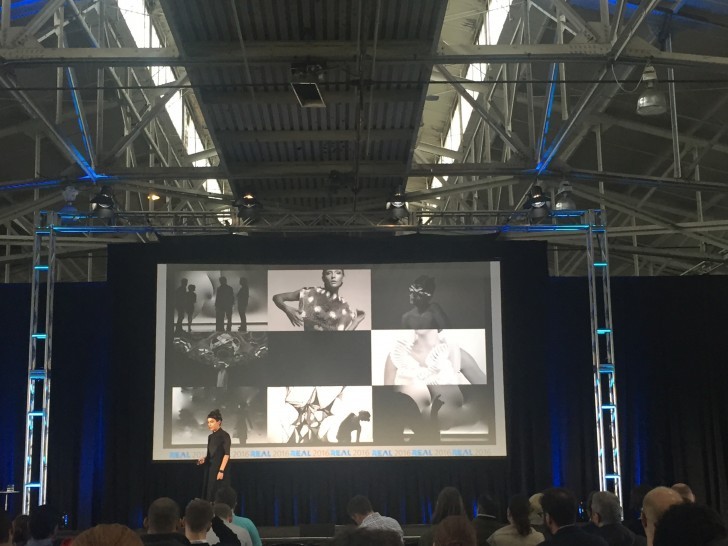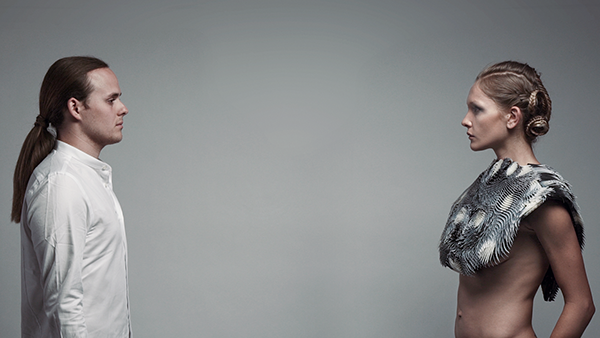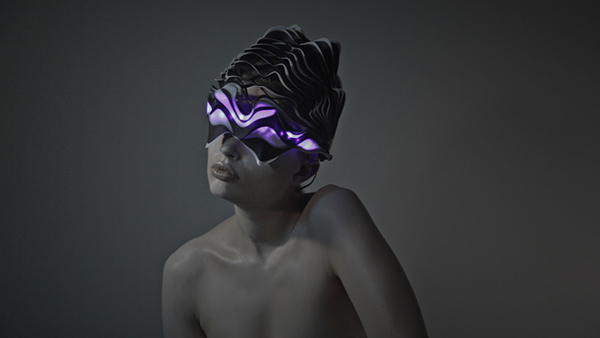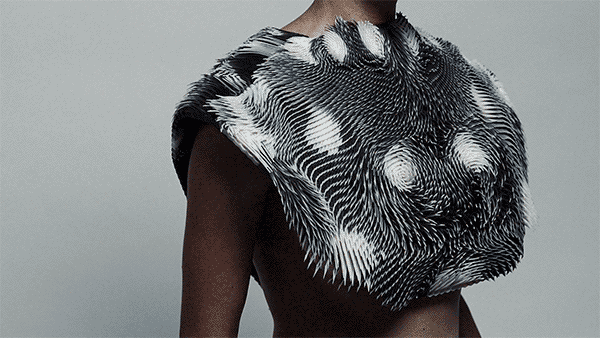Thus far, our coverage of the REAL 2016 conference has pertained to come pretty commercial industries. We’ve explored the all-encompassing term ‘Reality Computing’ as it relates to a variety of applications, and have seen how it’s being used to innovate the aerospace and medical industries. But one area we’ve yet to explore during our REAL coverage is art and fashion, both of which have become increasingly linked with digital fabrication and 3D printing technology. When it comes to melding the digital and physical worlds for the sake of art and fashion, not many designers can match nature-driven, dynamic work of California-based designer Behnaz Farahi. After watch her breathtaking presentation entitled ‘3D Printing Dynamic Body Architecture’, I had the opportunity to sit down with Farahi to discuss the combination of nature with the digital world, interactive body architecture, and why multi-material 3D printing is the best way to actualize her work.
Farahi considers herself to be an architect and an interaction designer, and though her projects have varied in style and content, her reoccurring motif is to connect human beings with their surrounding environment. With a keen interest in producing complex and dynamic geometries influenced by nature, Farahi has become quite familiar with multi-material 3D printing. As wholesome and complementary as nature may seem, our physical reality is composed of numerous materials equipped with different properties, ranging from soft to hard and everywhere in between. For Farahi, the ability to manipulate and blend material properties is what truly got her excited about 3D printing.

“For me, I got very fascinated by the techniques that you can produce with 3D printing because you could produce any complex geometries. It’s not just about form, necessarily, but also about how you can distribute the material across the scale and have different material properties,” Farahi told me. “It was really about producing geometries that can control material behavior; that’s what got me interested in multi-material 3D printing.”
Farahi’s form of art and fashion is based on the concept of body architecture. Inspired by the need to create complex geometries while studying architecture, Farahi saw 3D printing as the means to create what was previously deemed too complex to be done easily. She sees this emerging technology as a tool that takes designers outside of their confines, allowing them to replicate complex forms, such as nature, in a detailed and properly scaled way. “3D printing has changed our perception of what a material can be. We can think about materials as we see in nature and not worry about whether that material is easy or difficult to fabricate. It gives designers a way to go outside of the box,” Farahi explained.
In regards to Reality Computing, Farahi discussed how the transition from the physical to digital, at least in her work, is set on a sort of feedback loop. Take one her latest works, “Caress of the Gaze“, for instance. The piece is an interactive wearable that utilizes both multi-material 3D printing and an camera sensor system, which enables the material to shift in shape when it is being looked at. In a project like this, the exchange between the physical and digital never really ceases. Instead they continue to function together in a joint reality. The piece goes beyond digital fabrication and 3D printing, too. The 3D camera embedded within the garment also works by digitally capturing the physical, and, in turn, manipulates the physical properties of the wearable’s material.
“Even in the sensing part, you have the same back-and-forth between digital and physical, because, when you use a sensor, you’re basically capturing information from the outside world, but then you translate it into a digital information, and that digital information goes back to translate itself into a physical and tangible output,” Farahi explained. “For example, in ‘Caress of the Gaze’, I used the camera to capture the gaze of people around. This translates into digital information; the information goes to the micro-controller, and the micro-controller can control the motion of the outfit. So, you constantly have this feedback loop between physical and digital, digital and physical, and they’re informing each other.”

This combination of nature and the digital world is constantly reproduced in Farahi’s work, from her wearable “Synapse” headpiece to “The Living, Breathing Wall” exhibit. The main theme seems to always center around interaction and engagement, showing how digitization actually makes us more in tune with our physical reality. Synapse is a 3D printed helmet that moves and illuminates in response to the wearer’s brain activity, while The Living, Breathing Wall functioned as an installation that changes configuration and shape according to movement or words from the viewer. Though the work has come in all shapes and sizes, Farahi is constantly looking at nature to help innovate the digital world, and part of the answer always seems to fall back to 3D printing technology.

“The main thing is looking at nature. Everything in nature moves and responds to various stimuli, so I think it’s not just about fetishizing 3D printing as such, but about how you can use 3D printing to create something that – in terms of its morphology and behavior – it’s following things from nature,” Farahi said. “I’m really interested in seeing how 3D printing can help me, as a designer, to design things that are more organic and closer to living things.”

When Farahi and I talked about what she foresees in her future, she remained focused on the innovation of new fabrication materials. We talked about the MIT Media Lab’s work on 3D printing with naturally dynamic, reactive materials, which is where most of her excitement for the future seemed to rest. With this new style of digitally-charged fashion, Farahi believes that new materials will come along too, materials that are much more capable of replicating the expansive and ever-changing laws of nature. Someday soon, Farahi hopes to be dealing with materials that are both intelligent and aesthetically modifiable.
“I think that is where we’re heading to, and my work is aligned with that territory; however, they’re not implementing it in any sort of fashion-scale or human-body scale, because I do think that the materials of our garments will not be passive materials. It’s going to be new materials we have no idea about right now,” Farahi finished. “But they’ll be smart, able to change color and shape. So I think that’s what I’m excited to see: the industry moving forward to create materials that have dynamic properties, at the same time. The other thing I’m looking forward to advancement of soft materials, new elastomers and materials with elastic properties.”





